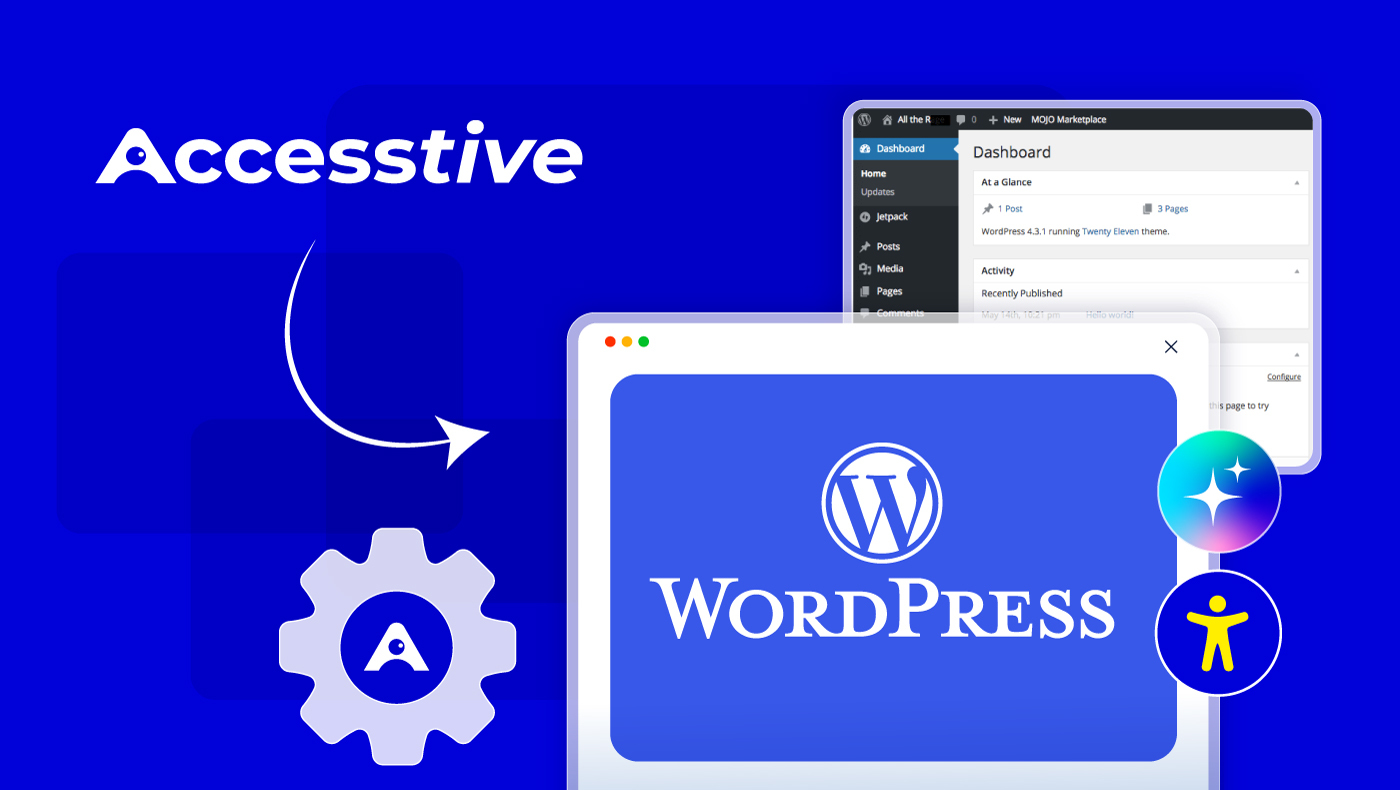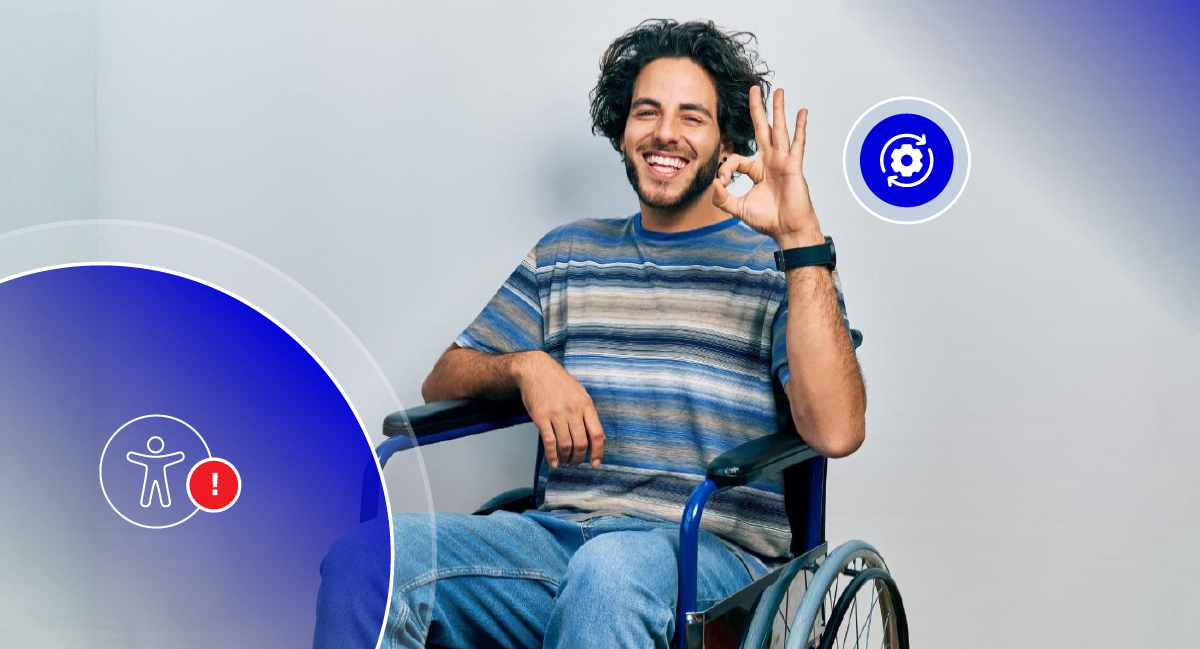Accessible Web Design | The Ultimate Guide for 2025

Why Accessible Web Design Is Essential in 2025
In 2025, accessible digital experiences aren’t just a nice-to-have, they’re a non-negotiable. With increasing legal requirements, growing user expectations, and a global push for ethical design, web accessibility has become a must-have skill for developers, designers, content creators, and business leaders alike.
This guide will walk you through:
- What accessible web design really means (beyond just alt text)
- Why accessibility is crucial for both users and businesses
- How to apply WCAG best practices in real-world scenarios
- Tools, checklists, and examples to help you get it right
Let’s build a web that welcomes everyone, starting with your next project.
What Is Web Accessibility?
Web accessibility is the practice of designing and developing websites so that everyone, including people with disabilities, can access, understand, navigate, and interact with them without barriers. It ensures that content is usable by individuals who may rely on screen readers, keyboard navigation, or other assistive technologies.
At its core, accessible web design isn’t just a technical requirement; it’s a commitment to digital inclusivity. It involves using clean semantic HTML, descriptive alt text for images, logical heading structures, and proper color contrast to ensure that content is perceivable, operable, understandable, and robust (POUR).
Whether someone has a permanent disability (like blindness), a temporary condition (like a broken arm), or situational limitations (like bright sunlight), web accessibility ensures that the digital experience remains smooth and barrier-free.
Benefits of Accessible Design
Accessible design goes far beyond compliance, it creates better user experiences, opens up your website to a wider audience, and boosts your bottom line. Here's how:
- Reach a Larger Audience
Over a billion people worldwide live with a disability. An accessible website welcomes everyone, increasing traffic and engagement across all devices and contexts. - Improve SEO Naturally
Search engines and assistive technologies both love semantic structure, alt attributes, and clear content hierarchies, all core parts of web accessibility. - Reduce Bounce Rates and Improve UX
Clean design and keyboard-friendly navigation help all users, including those without disabilities, stay longer and convert more. - Minimize Legal Risks
Inaccessible websites risk lawsuits in many regions. Adopting accessible web design practices helps meet standards like WCAG, ADA, and EN 301 549. - Build a Future-Ready Brand
Digital accessibility is becoming a standard expectation. Showing you care about inclusive design boosts trust and positions your brand as forward-thinking.
Explore how TYPO3’s accessibility features make your site better for everyone.
Who Benefits from Accessible Design?
While accessibility is often associated with users who are blind or visually impaired, its reach is much broader:
- People with visual, auditory, motor, or cognitive disabilities
- Older adults who may struggle with small text or confusing interfaces
- Mobile users dealing with low contrast in bright light
- Temporary limitations, like a broken wrist or an eye injury
- Situational challenges, like multitasking or using a slow internet connection
By investing in website accessibility, you're not just checking a compliance box, you're creating a digital space that welcomes all users, in all scenarios.
Accessibility Laws and Standards
What Are the Web Content Accessibility Guidelines (WCAG)?
The Web Content Accessibility Guidelines (WCAG) are the global standard for creating accessible websites. Developed by the W3C, WCAG provides a set of technical and design principles to ensure websites are usable by people with disabilities.
These guidelines are organized under four key principles, known as POUR:
- Perceivable: Content must be presented in ways users can perceive (e.g., captions for videos).
- Operable: All navigation and functionality must be usable with a keyboard or assistive device.
- Understandable: Content should be readable and predictable.
- Robust: Websites must work across a wide range of devices and assistive technologies.
WCAG has evolved through multiple versions, WCAG 2.0, 2.1, and 2.2 (released in 2023), with WCAG 3.0 currently in draft.
Want to dive deeper? Explore our complete guide to WCAG 2.2
Why Level AA Is the Industry Standard
WCAG has three levels of conformance: Level A (basic), Level AA (intermediate), and Level AAA (advanced). Most organizations aim for Level AA, and here’s why:
- It's the minimum requirement for legal compliance in many countries (e.g., ADA in the U.S., BITV in Germany).
- It balances usability and implementation, improving digital accessibility for most users without over-complicating design or development.
- Level AA includes vital features like color contrast, resizable text, error identification, and consistent navigation.
Want examples of what Level AA looks like in action? Check out WCAG Conformance Levels
Accessibility Laws Across the World
Accessibility isn’t just good practice; it's the law in many regions. Here's a quick look at global digital accessibility laws:
| Country/Region | Law | Scope |
| USA | ADA (Americans with Disabilities Act) | Applies to public-facing websites; enforced via lawsuits |
| EU | EN 301 549, European Accessibility Act | Applies to public & private sector websites and apps |
| Germany | BITV 2.0 | Enforces WCAG 2.1 AA for government and public sites |
| Canada | ACA, AODA | Federal and Ontario-specific laws requiring WCAG AA |
| Global | WCAG is widely adopted | De facto standard for compliance across markets |
Even if your site isn't required by law today, lawsuits and regulations are rapidly expanding, especially in the U.S. and Europe.
New to ADA? Read: ADA vs WCAG: US’s Web Accessibility Law Explained
How to Become Legally Compliant
Getting your website legally compliant with accessibility standards isn’t just about ticking boxes, it's a process of aligning design, development, and content strategy with user needs.
Here’s a simple roadmap to begin:
- Audit Your Website
Run an automated and manual accessibility audit (using tools like Access Free Audit or the WAVE tool). - Fix Critical Issues
Address major blockers first, missing alt text, keyboard traps, low color contrast, missing form labels, etc. - Follow WCAG Guidelines
Use WCAG 2.1 AA as your benchmark. Implement semantic HTML, clear focus states, and accessible navigation patterns. - Implement Structured Accessibility Testing
Involve real users or testers with disabilities for feedback. Regularly retest and track improvements. - Stay Up-to-Date
Laws evolve. Make digital accessibility part of your ongoing website strategy, not just a one-time fix.
Want expert help with compliance? Explore Access Services by Accesstive
Why Accessible Design Matters in 2025
In today’s digital-first world, building an accessible web design isn’t just a nice-to-have, it’s a necessity. Whether you run an e-commerce store, a corporate website, or a public service portal, integrating website accessibility ensures a better experience for everyone. Let’s break down the key reasons why accessibility should be central to your digital strategy in 2025.
1. Reach a Broader, Often Overlooked Audience
Over 1.3 billion people globally live with some form of disability. This includes individuals with visual, auditory, motor, cognitive, or neurological challenges. When your website follows web accessibility standards, you make sure your content and services are usable by this large, and often ignored, segment of the population. That’s not just good ethics; it’s good business.
2. Boost SEO with Semantic, Clean Code
Accessible web design naturally aligns with SEO best practices. Search engines love clean HTML structures, semantic elements, meaningful alt attributes, and logical heading hierarchies, all pillars of accessibility. When your site is accessible, it’s also easier for Google to crawl, index, and rank, helping you attract more organic traffic without additional SEO efforts.
3. Create a Better User Experience for Everyone
The same features that help users with disabilities also improve usability for all visitors. Clear navigation, responsive layouts, readable fonts, and keyboard-friendly interfaces are examples of digital accessibility features that enhance the user journey for every single visitor, regardless of their abilities or the device they’re using.
4. Avoid Legal Trouble and Stay Compliant
Accessibility isn’t just a design choice, it’s the law in many countries. Regulations like the ADA (Americans with Disabilities Act) in the U.S., Barrierefreie-Informationstechnik-Verordnung (BITV) in Germany, and the European Accessibility Act (EAA) require websites to meet certain web accessibility standards, such as WCAG. Ignoring these guidelines can result in lawsuits, government fines, and damage to your reputation.
12 Must-Have Features for Accessible
Building an accessible website isn’t just about following standards, it’s about crafting digital experiences that are welcoming and usable for everyone. Below are 12 essential features that every website should implement to meet modern web accessibility requirements in 2025, along with examples to help you visualize their impact.
1. Clear Heading Structure
Using a logical hierarchy of headings (<h1> to <h6>) makes it easier for screen readers and keyboard users to understand the content structure. For example, an FAQ page with properly nested headings allows users to jump between questions without scrolling endlessly.
2. Descriptive Alt Text for Images
Every image should have alt text that clearly describes its purpose or content. On an eCommerce product page, an image of a red sneaker should have alt text like “Red running shoes with white sole – Men’s size 10” instead of just “shoe.”
3. Sufficient Color Contrast
Text and background colors need enough contrast to be readable for users with low vision or color blindness. For instance, using black text on a white background meets contrast standards, while light gray text on a light background may fail.
4. Keyboard Navigation
All interactive elements, like menus, forms, and buttons, should be usable without a mouse. Try navigating your homepage using just the Tab key. If you can’t reach every element, your website accessibility needs work.
5. Properly Labeled Form Fields
Forms should include visible labels and associated HTML <label> elements. For example, instead of placeholder-only forms, a contact form should have a label like “Email Address” clearly linked to its input field so screen readers can identify it.
6. Visible Focus Indicators
When users navigate with a keyboard, there should be a clear visual outline or highlight (called a focus indicator) showing which element is selected. Think of the glowing blue box you see when tabbing through YouTube’s homepage.
7. Captions and Transcripts for Multimedia
Any video or audio content should have accurate captions or transcripts. If you have a product demo video, captions help users who are deaf or watching in silent mode, and transcripts allow search engines to index your video content, win-win!
8. Scalable Text and Zoom Support
Users should be able to enlarge text up to 200% without losing functionality or breaking your layout. A well-coded accessible web design will reflow content instead of overlapping elements or hiding parts of the page.
9. Avoid Flashing Content
Fast-flashing animations (especially those flashing more than three times per second) can trigger seizures in people with photosensitive epilepsy. Instead of using flashy banners, use gentle fade-ins or subtle motion effects with control options.
10. “Skip to Content” Link
A hidden but accessible “Skip to main content” link at the top of the page allows keyboard and screen reader users to bypass headers and navigation menus. This tiny link is a huge time-saver, especially on content-heavy sites like blogs or news portals.
11. Accessible PDFs and Documents
All downloadable content, especially PDFs, should be created with accessibility in mind. For example, an accessible PDF should have tagged headings, searchable text, and alternative text for images, ensuring compatibility with screen readers like JAWS or NVDA.
12. Mobile Responsiveness with Accessibility in Mind
Your site should work well across devices, but don’t stop at responsiveness. Buttons should be large enough to tap, text should adjust properly on zoom, and mobile screen readers like VoiceOver or TalkBack should be able to interpret all elements without errors.
How to Design an Accessible Website: Step-by-Step
1. Start with Semantic HTML
Use proper HTML5 tags like <header>, <main>, <article>, and <footer> to structure your content. For example, replace <div class="title"> with a meaningful <h1>. This boosts both website accessibility and SEO by giving screen readers clear navigation cues.
2. Use ARIA Roles Sparingly (but Smartly)
ARIA roles like aria-label, aria-hidden, and role="dialog" help enhance accessible web design when native HTML can't. For instance, add aria-live="polite" to alert users of dynamic changes in a form. But don't overuse ARIA, clean, semantic HTML is always the first choice.
3. Ensure Full Keyboard Accessibility
All functions, menus, popups, carousels, must be operable via keyboard alone. For example, users should navigate your site with just Tab and Enter, without needing a mouse. This is critical for people with motor disabilities and enhances usability across the board.
4. Provide Text Alternatives for All Media
Every image should include descriptive alt text, like: <img src="map.png" alt="Map showing TYPO3 user locations in Germany">. Add captions to videos and transcripts to podcasts to support users with hearing loss. These also improve digital accessibility and page rankings.
5. Check Contrast & Readability Like a Pro
Maintain a minimum contrast ratio of 4.5:1 for body text using tools like WebAIM’s Contrast Checker. For example, don’t pair light gray text on a white background. Strong color contrast and readable fonts make your site accessible to users with low vision or dyslexia.
Real-World Example: Accessibility in Action
A city council in Germany rebuilt its website using WCAG-compliant and accessible web design standards. The new layout prioritized semantic HTML, screen reader compatibility, and clean navigation. This ensured all citizens, including those with disabilities, could use the site with ease.
After the launch, the bounce rate dropped by 28%, showing people were staying longer and exploring more. Form submissions increased by 36%, proving users could finally complete key tasks like feedback and applications. The site became more functional for everyone, not just those with disabilities.
The council also received direct praise from users with disabilities, who felt empowered and included. It’s proof that digital accessibility improves real-world outcomes. When usability meets inclusivity, the entire experience levels up, for users and the business.
Tools to Test and Improve Web Accessibility
| Tool | What It Does |
| WAVE | Visual tool that highlights accessibility errors directly on your webpage |
| Axe DevTools | Chrome/Firefox extension for quick, automated accessibility audits |
| Lighthouse | Built-in Chrome tool to measure performance, SEO, and accessibility |
| NVDA / VoiceOver | Screen readers for testing real-world user experience (Windows / macOS) |
| tota11y | Adds a visual overlay to show how assistive tech "sees" your content |
| Access Audit | automated accessibility audit tool |
Pro Tips for Web Accessibility
Don’t rely on color alone to convey meaning.
For example, instead of just using red text for errors, add an icon and message like “Please enter a valid email.” This ensures people with color blindness or low vision can still understand your content.
Avoid placing important text inside images.
Text in images can’t be resized, translated, or read by screen readers. Always use real, selectable text in your design to improve both digital accessibility and user experience across all devices.
Ensure tooltips, popups, and modals are accessible.
They should be fully keyboard-navigable and include ARIA roles like aria-describedby. For example, a modal contact form should trap focus and close with the Escape key, making your website accessibility airtight.
Include an accessibility statement on your website.
This shows users you're committed to accessible web design and helps them find support if needed. You can easily create one using Compliance Hub for credibility and clarity.
Conclusion
Accessible web design is no longer just a technical checklist, it’s a human-centered approach to digital innovation. By creating sites that everyone can use, you build trust, reach a wider audience, and future-proof your brand.
The path to accessibility may seem complex, but every step counts. Start today, and you'll not only meet standards, you’ll exceed expectations.
Let’s make the web better for everyone. Need help implementing accessible design? Visit the Accesstive Help Center now!!
FAQs About Accessible Web Design
Accessible web design ensures that websites can be used by everyone, including people with disabilities. It involves creating content and interfaces that are perceivable, operable, understandable, and robust, making sure no one is excluded from digital experiences.
It means that no matter a person’s physical or cognitive ability, they can access, understand, and interact with your site. From screen reader compatibility to proper color contrast, everything works for everyone. Accessibility removes digital barriers.
UX focuses on how enjoyable and usable a site is for the average user. Accessibility ensures everyone, regardless of ability, can have that same smooth experience. Think of accessibility as UX without exclusion.
Costs range from $500 for basic fixes to $10,000+ for large or complex sites. It depends on your site’s size, platform, and current accessibility level. Investing in accessibility also saves future legal costs.
According to the Web Content Accessibility Guidelines (WCAG), accessible content must be:
- Perceivable – Users must be able to perceive the content (e.g., alt text for images).
- Operable – Interface elements must be usable via keyboard or assistive tech.
- Understandable – Content and navigation should be clear and predictable.
- Robust – Content must work reliably across technologies, including assistive tools.
While not specific to accessibility, these general design principles create a strong visual and functional foundation:
- Balance – Visual stability through even distribution
- Contrast – Clear difference between elements (also key for accessibility!)
- Emphasis – Focus on the most important elements
- Movement – Guides the user’s eye across a layout
- Proportion – Sizing relationships between elements
- Repetition – Reinforces consistency and usability
- Unity – Brings all elements together cohesively
The WCAG 2.1 AA level is widely accepted as the legal benchmark in most countries.
Start with an automated tool like WAVE, or a free AI-powered accessibility checker, and then do manual testing with a screen reader and keyboard.
Yes, accessible design applies across devices,responsive layouts, touch targets, and voice assistance compatibility all matter.
No, all organizations, including startups and eCommerce sites, should design inclusively. It’s a business advantage.
Yes. While it’s easier to build accessibly from the start, most accessibility issues can be fixed retroactively.
No, all organizations, including startups and eCommerce sites, should design inclusively. It’s a business advantage.
Yes. In the U.S., non-ADA-compliant sites have faced lawsuits, especially in eCommerce, hospitality, and education. Penalties can include thousands in legal fees, settlements, or mandated remediation.
If you're referring to access control, make sure permissions, passwords, and login systems are usable and accessible. If you mean design access, ensure your site meets accessibility guidelines and works for all users, including those using assistive tools.




